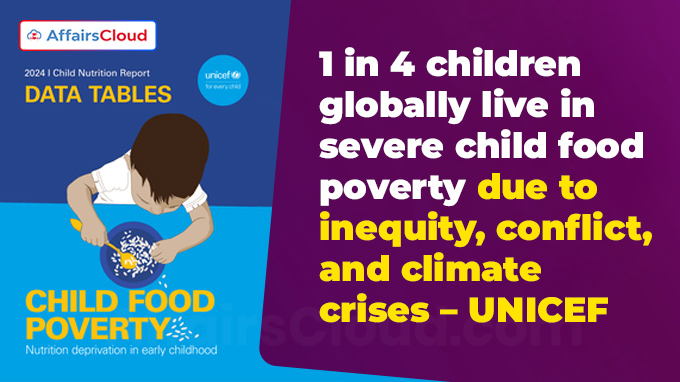
According to the United Nations Children’s Fund (UNICEF)’s 2024 Child Nutrition Report titled “Child Food Poverty: Nutrition Deprivation in Early Childhood”, globally, 1 in 4 children (27%) are living in severe child food poverty in early childhood, this amounts to around 181 million children under 5 years of age.
- These children are 50% more likely to experience wasting, a form of malnutrition which is defined as low weight-for-height.
- For the first time, this report examines dietary deprivation among the world’s youngest people in nearly 100 countries, and across all income groups.
About the Report:
i.This global report examines the status, trends, inequities, and drivers of child food poverty in early childhood, highlighting the impact of global and local food and nutrition crises.
ii.It focuses on low- and middle-income countries, where child food poverty is prevalent, and highlights the implications of child food poverty for undernutrition and poor development.
Child food poverty:
i.Child food poverty is measured using the UNICEF and World Health Organization (WHO) dietary diversity score.
ii.Children should consume foods from at least 5 out of the 8 defined food groups to achieve minimum dietary diversity for a healthy growth and development.
iii.If children are fed:
- 0–2 food groups/day, they are living in severe child food poverty;
- 3–4 food groups/day, they are living in moderate child food poverty; and
- 5 or more food groups/day, they are not living in child food poverty.
Impact of Conflict:
i.In Somalia, 63% of children are living in severe child food poverty, and this is more in the most vulnerable communities.
ii.9 out of 10 children in the Gaza Strip are consistently experiencing severe food poverty, surviving on 2 or fewer food groups per day.
Positive Trends:
i.Burkina Faso: Reduced severe child food poverty from 67% (2010) to 32% (2021).
iiNepal: Decreased severe child food poverty from 20% (2011) to 8% (2022).
iii.Peru: Maintained rates below 5% since 2014.
iv.Rwanda: Reduced severe child food poverty from 20% (2010) to 12% (2020).
Key Findings:
i.Millions of children under 5 lack access to a nutritious, diverse diet essential for optimal growth and development. This deprivation impacts early childhood and long-term health and development.
ii.Less than 5% are fed nutrient-dense foods such as eggs, fish, poultry, or meat.
iii.Of the 181 million children, 65% of affected children live in 20 countries (including India), with high numbers in South Asia (around 64 million) and Sub-Saharan Africa (59 million).
iv.46% (nearly half) of all severe child food poverty cases are among poor households. Income poverty is a major driver in these cases and 54% (97 million children) in wealthier households face food poverty, driven by poor food environments and feeding practices.
v.To end child food poverty, UNICEF outlines an agenda for tackling the problem, recommending action to transform food systems, leverage health systems and activate social protection systems to bring children’s rights to food and nutrition to focus.
Additional: To accelerate actions to prevent, detect and treat severe child food poverty and malnutrition, the Child Nutrition Fund (CNF) was launched in 2023 by UNICEF, with the support of the UK Foreign Commonwealth and Development Office (FCDO), the Bill and Melinda Gates Foundation, and the Children’s Investment Fund Foundation (CIFF).
Recent related News:
On 27 March 2024, the UN Environment Programme (UNEP) released its “Food Waste Index Report 2024-Think Eat Save Tracking Progress to Halve Global Food Waste” which tracks the progress of countries to halve food waste by 2030.
About the United Nations Children’s Fund (UNICEF):
UNICEF was established in 1946 as the United Nations International Children’s Emergency Fund (UNICEF). It was renamed as United Nations Children’s Fund (UNICEF) in 1953
Executive Director– Catherine M. Russell
Headquarters– New York, The United States of America (USA)




